Paper Menu >>
Journal Menu >>
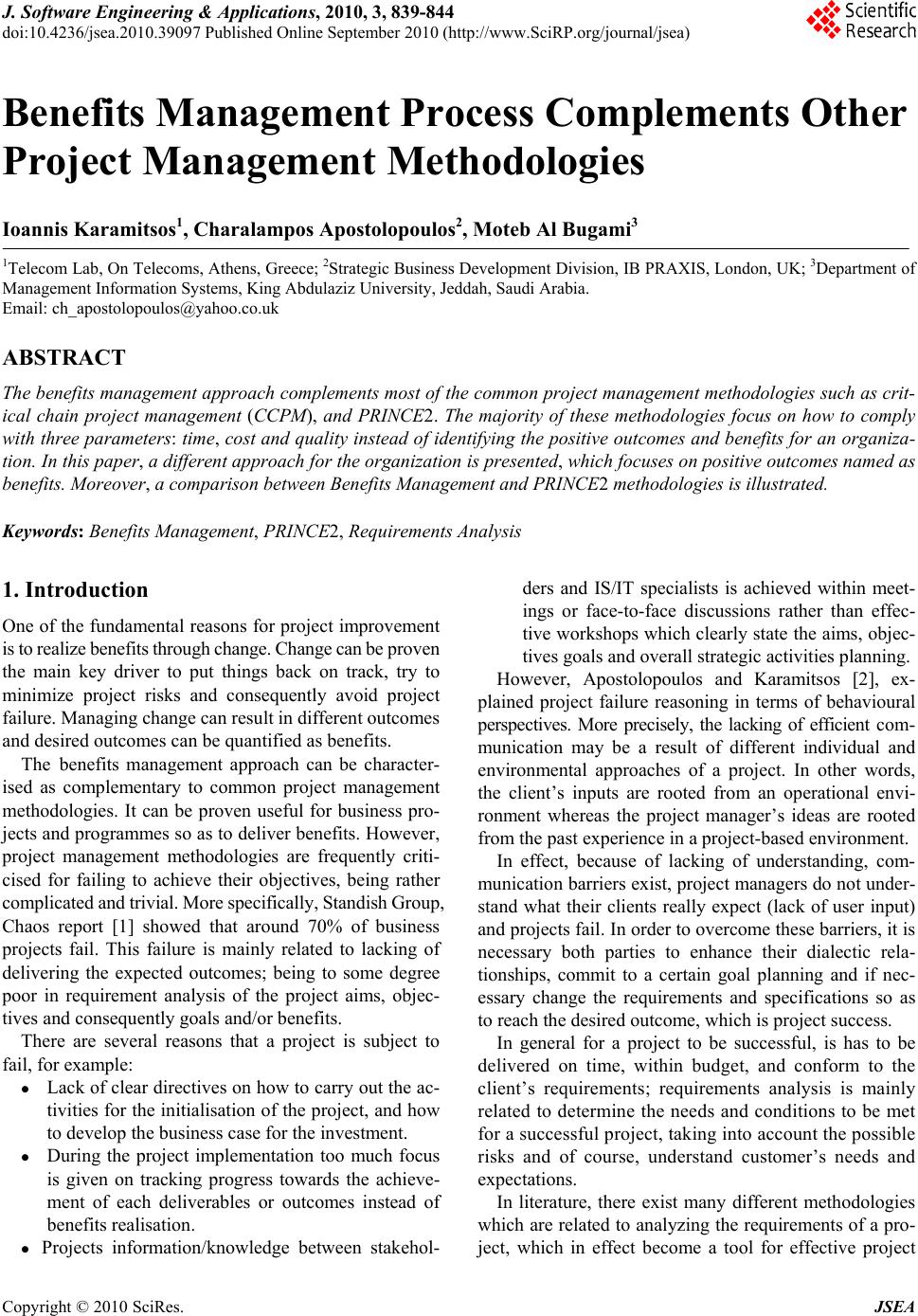 J. Software Engineering & Applications, 2010, 3, 839-844 doi:10.4236/jsea.2010.39097 Published Online September 2010 (http://www.SciRP.org/journal/jsea) Copyright © 2010 SciRes. JSEA 839 Benefits Management Process Complements Other Project Management Methodologies Ioannis Karamitsos1, Charalampos Apostolopoulos2, Moteb Al Bugami3 1Telecom Lab, On Telecoms, Athens, Greece; 2Strategic Business Development Division, IB PRAXIS, London, UK; 3Department of Management Inform a ti o n Systems, King Abdulaziz University, Jeddah, Saudi Arabia. Email: ch_apostolopoulos@yahoo.co.uk ABSTRACT The benefits managemen t approach complemen ts most of the common project ma nagement methodologies such a s crit- ical chain project management (CCPM), and PRINCE2. The majority of these methodologies focus on how to comply with three parameters: time, cost an d quality instead of identifying th e positive outcomes and benefits for an organiza- tion. In this paper, a different approach for the organization is presented , which focuses on positive outcomes named as benefits. Moreover, a comparison between Benefits Management and PRINCE2 methodologies is illustra ted. Keywords: Benefits Management, PRINCE2, Requirements Analysis 1. Introduction One of the fundamental reasons for project improvement is to realize benefits through change. Change can be proven the main key driver to put things back on track, try to minimize project risks and consequently avoid project failure. Managing change can result in different outcomes and desired outcomes can be quantified as benefits. The benefits management approach can be character- ised as complementary to common project management methodologies. It can be proven useful for business pro- jects and programmes so as to deliver benefits. However, project management methodologies are frequently criti- cised for failing to achieve their objectives, being rather complicated and trivial. More specifically, Standish Group, Chaos report [1] showed that around 70% of business projects fail. This failure is mainly related to lacking of delivering the expected outcomes; being to some degree poor in requirement analysis of the project aims, objec- tives and consequently goals and/or benefits. There are several reasons that a project is subject to fail, for example: Lack of clear directives on how to carry out the ac- tivities for the initialisation of the project, and how to develop the business case for the investment. During the project implementation too much focus is given on tracking progress towards the achieve- ment of each deliverables or outcomes instead of benefits realisation. Projects information/knowledge between stakehol- ders and IS/IT specialists is achieved within meet- ings or face-to-face discussions rather than effec- tive workshops which clearly state the aims, objec- tives goals and overall strategic activities planning. However, Apostolopoulos and Karamitsos [2], ex- plained project failure reasoning in terms of behavioural perspectives. More precisely, the lacking of efficient com- munication may be a result of different individual and environmental approaches of a project. In other words, the client’s inputs are rooted from an operational envi- ronment whereas the project manager’s ideas are rooted from the past experience in a project-based environment. In effect, because of lacking of understanding, com- munication barriers exist, project managers do not under- stand what their clients really expect (lack of user input) and projects fail. In o rder to overco me these barriers, it is necessary both parties to enhance their dialectic rela- tionships, commit to a certain goal planning and if nec- essary change the requirements and specifications so as to reach the desired outcome, which is project success. In general for a project to be successful, is has to be delivered on time, within budget, and conform to the client’s requirements; requirements analysis is mainly related to determine the needs and conditions to be met for a successful project, taking into account the possible risks and of course, understand customer’s needs and expectations. In literature, there exist many different methodologies which are related to analyzing the requirements of a pro- ject, which in effect become a tool for effective project 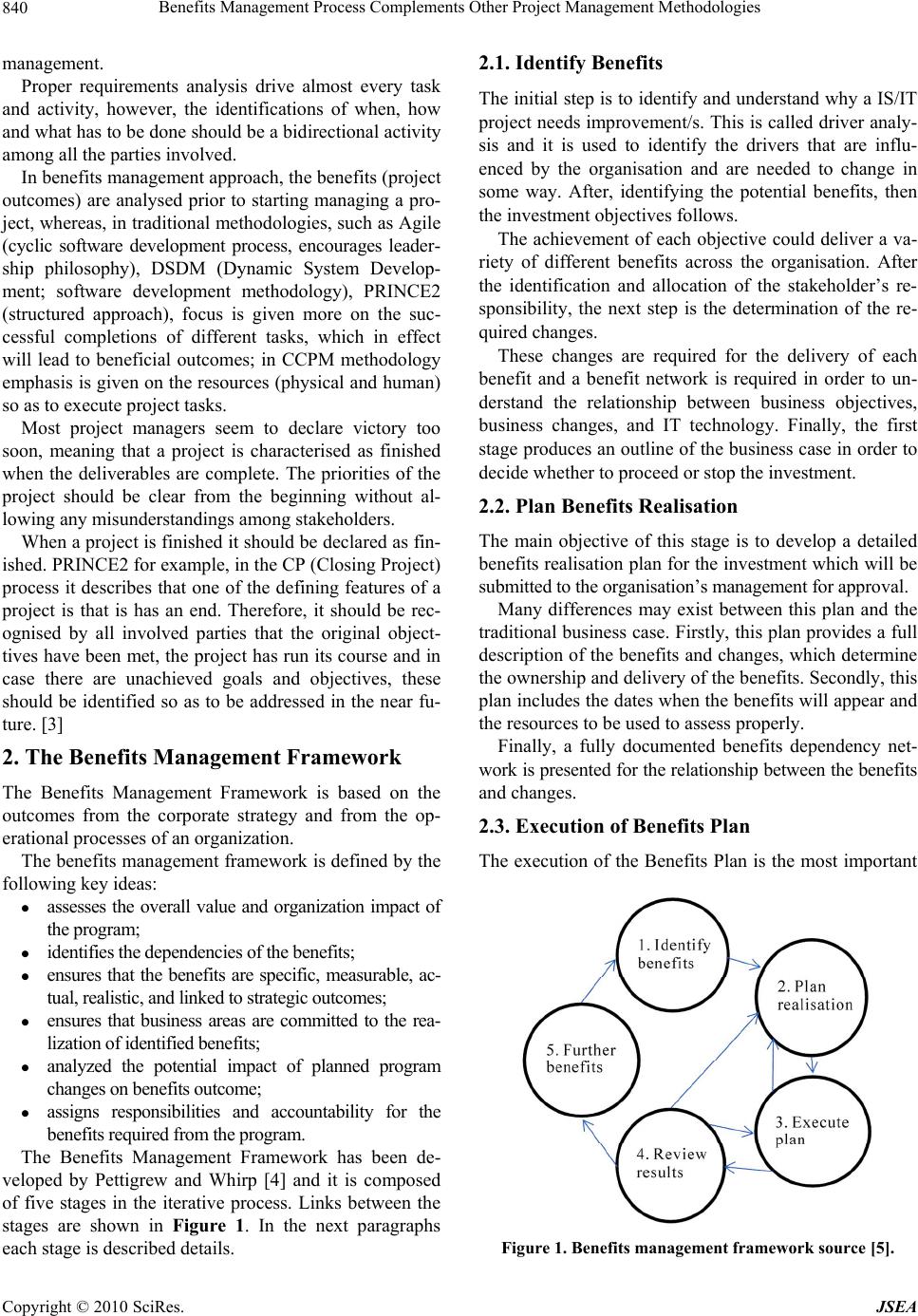 Benefits Management Process Complements Other Project Management Methodologies Copyright © 2010 SciRes. JSEA 840 management. Proper requirements analysis drive almost every task and activity, however, the identifications of when, how and what has to be done should be a bidirectional activity among all the parties involved. In benefits management approach, the benefits (project outcomes) are analysed prior to starting managing a pro- ject, whereas, in traditional methodo logies, such as Agile (cyclic software development process, encourages leader- ship philosophy), DSDM (Dynamic System Develop- ment; software development methodology), PRINCE2 (structured approach), focus is given more on the suc- cessful completions of different tasks, which in effect will lead to beneficial outcomes; in CCPM methodology emphasis is given on the resources (physical and human) so as to execute project tasks. Most project managers seem to declare victory too soon, meaning that a project is characterised as finished when the deliverables are complete. The priorities of the project should be clear from the beginning without al- lowing any misunderstandings among stakeholders. When a project is finish ed it should be declared as fin- ished. PRINCE2 for example, in the CP (Closing Project) process it describes that one of the defining features of a project is that is has an end. Therefore, it should be rec- ognised by all involved parties that the original object- tives have been met, the project has run its course and in case there are unachieved goals and objectives, these should be identified so as to be addressed in the near fu- ture. [3] 2. The Benefits Management Framework The Benefits Management Framework is based on the outcomes from the corporate strategy and from the op- erational processes of an organization. The benefits management framework is defined by the following key ideas: assesses the overall value and organization impact of the program; i denti fies t he depe nde ncies of the be nefit s; ensures that the benefits are specific, measurable, ac- tual, realistic, and linked to strategic outcomes; ensures that business areas are committed to the rea- lization of identified benefits; analyzed the potential impact of planned program changes on benefits outcome; assigns responsibilities and accountability for the benefits required from the program. The Benefits Management Framework has been de- veloped by Pettigrew and Whirp [4] and it is composed of five stages in the iterative process. Links between the stages are shown in Figure 1. In the next paragraphs each stage is described details. 2.1. Identify Benefits The initial step is to identify an d understand why a IS/IT project needs improvement/s. This is called driver analy- sis and it is used to identify the drivers that are influ- enced by the organisation and are needed to change in some way. After, identifying the potential benefits, then the investment objectives follows. The achievement of each objective could deliver a va- riety of different benefits across the organisation. After the identification and allocation of the stakeholder’s re- sponsibility, the next step is the determination of the re- quired changes. These changes are required for the delivery of each benefit and a benefit network is required in order to un- derstand the relationship between business objectives, business changes, and IT technology. Finally, the first stage produces an outline of the bu siness case in order to decide whether to proceed or stop the invest m e nt . 2.2. Plan Benefits Realisation The main objective of this stage is to develop a detailed benefits realisation plan for the investment which will be submitted to the organisation’s m anagem ent for approval. Many differences may exist between this plan and the traditional business case. Firstly, this plan provides a full description of the benefits and changes, which determine the ownership and deliv ery of the benefits. Second ly, this plan includes the dates when the benefits will appear and the resources to be used to assess properly. Finally, a fully documented benefits dependency net- work is presented for the relationship between the benefits and changes. 2.3. Execution of Benefits Plan The execution of the Benefits Plan is the most important Figure 1. Benefits management framework source [5]. 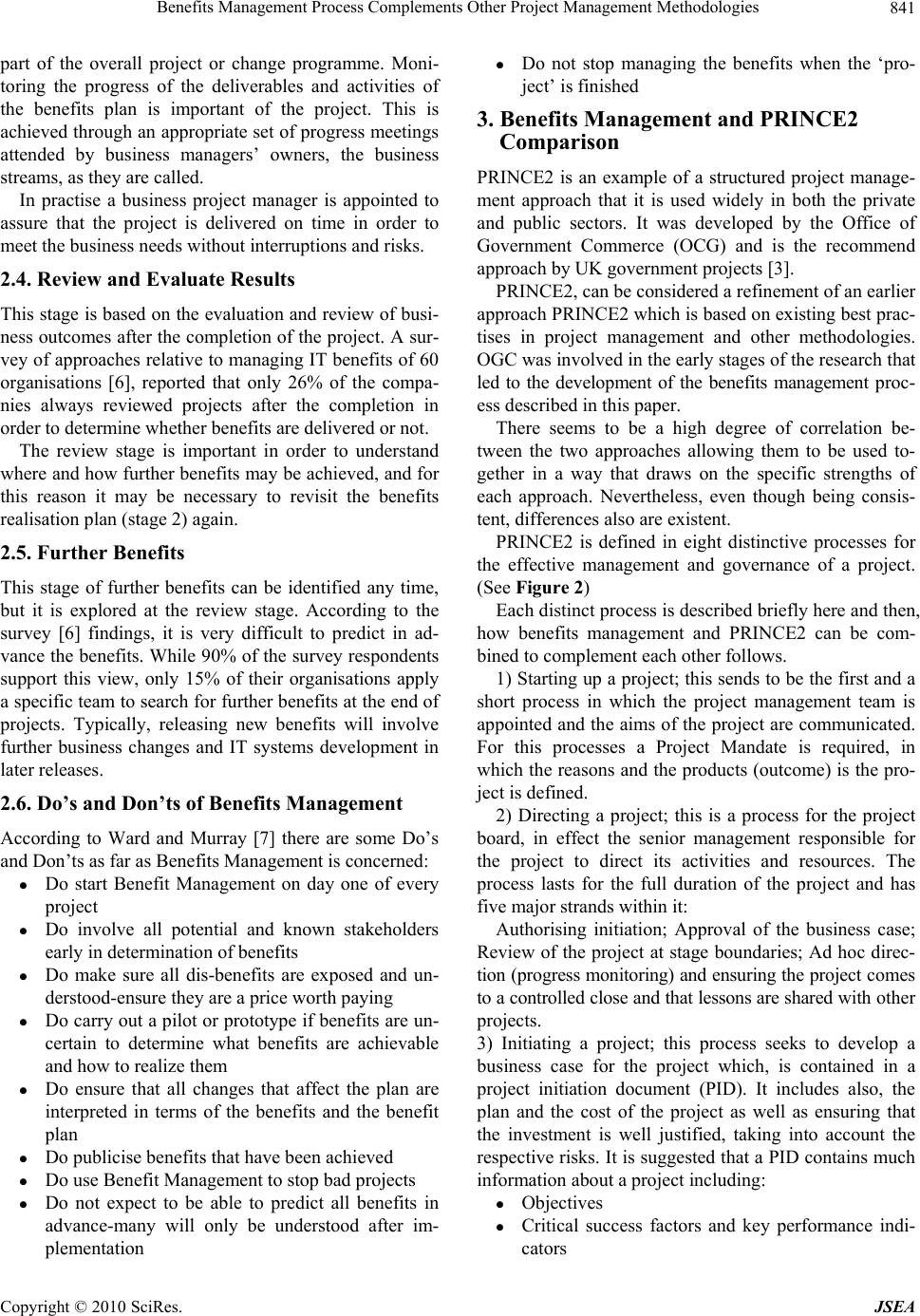 Benefits Management Process Complements Other Project Management Methodologies Copyright © 2010 SciRes. JSEA 841 part of the overall project or change programme. Moni- toring the progress of the deliverables and activities of the benefits plan is important of the project. This is achieved through an app ropriate set of progress meetings attended by business managers’ owners, the business streams, as they are called. In practise a business project manager is appointed to assure that the project is delivered on time in order to meet the business needs without interruptions and risks. 2.4. Review and Evaluate Results This stage is based on the evaluation and review of busi- ness outcomes after the completion of the project. A sur- vey of approa ches relative to managing IT benefits of 60 organisations [6], reported that only 26% of the compa- nies always reviewed projects after the completion in order to determine whether benefits are delivered or not. The review stage is important in order to understand where and how further benefits may be achieved, and for this reason it may be necessary to revisit the benefits realisation plan (stage 2) again. 2.5. Further Benefits This stage of further benefits can be identified any time, but it is explored at the review stage. According to the survey [6] findings, it is very difficult to predict in ad- vance the benefits. While 90% of the survey respondents support this view, only 15% of their organisations apply a specific team to search for further benefits at the end of projects. Typically, releasing new benefits will involve further business changes and IT systems development in later releases. 2.6. Do’s and Don’ts of Benefits Management According to Ward and Murray [7] there are some Do’s and Don’ts as far as Benefits Management is concerned: Do start Benefit Management on day one of every project Do involve all potential and known stakeholders early in determination of benefits Do make sure all dis-benefits are exposed and un- derstood-ensure they are a price worth paying Do carry out a pilot or prototype if benefits are un- certain to determine what benefits are achievable and how to realize them Do ensure that all changes that affect the plan are interpreted in terms of the benefits and the benefit plan Do publicise benefits that have been achieved Do use Benefit Management to stop bad projects Do not expect to be able to predict all benefits in advance-many will only be understood after im- plementation Do not stop managing the benefits when the ‘pro- ject’ is finished 3. Benefits Management and PRINCE2 Comparison PRINCE2 is an example of a structured project manage- ment approach that it is used widely in both the private and public sectors. It was developed by the Office of Government Commerce (OCG) and is the recommend approach by UK government projects [3]. PRINCE2, can be considered a refinement of an earlier approach PRINCE2 which is based on existing best prac- tises in project management and other methodologies. OGC was involved in the early stages of the research that led to the development of the benefits management proc- ess described in this paper. There seems to be a high degree of correlation be- tween the two approaches allowing them to be used to- gether in a way that draws on the specific strengths of each approach. Nevertheless, even though being consis- tent, differences also are existent. PRINCE2 is defined in eight distinctive processes for the effective management and governance of a project. (See Figure 2 ) Each distinct process is described briefly here and then, how benefits management and PRINCE2 can be com- bined to complement each other follows. 1) Starting up a project; th is sends to be the first and a short process in which the project management team is appointed and the aims of the project are communicated. For this processes a Project Mandate is required, in which the reasons and the products (outcome) is the pro- ject is defined. 2) Directing a project; this is a process for the project board, in effect the senior management responsible for the project to direct its activities and resources. The process lasts for the full duration of the project and has five major strands within it: Authorising initiation; Approval of the business case; Review of the project at stage boundaries; Ad hoc direc- tion (progress monitoring) and ensuring the project comes to a controlled close and that lessons are shared with o th e r projects. 3) Initiating a project; this process seeks to develop a business case for the project which, is contained in a project initiation document (PID). It includes also, the plan and the cost of the project as well as ensuring that the investment is well justified, taking into account the respective risks. It is suggested that a PID contains much information about a project including: Objectives Critical success factors and key performance indi- cators  Benefits Management Process Complements Other Project Management Methodologies Copyright © 2010 SciRes. JSEA 842 Figure 2. Effective management and governance processes source: OGC, PRINCE2 [3]. Impacts and assumptions Constraints and option evaluations Benefits analysis Project costs Cost/benefit analysis Risks Delivery plan- including stages or milestones 4) Controlling a stage; one of the key principles in PRINCE2; controlling projects is to break them into manageable, smaller stages. In th is process it is described the monitoring and control activities, which are required to keep a stage on track. 5) Managing product delivery; specifies the contract between the project and suppliers. In effect the objective of this process is to ensure that planned products (out- come) are delivered as predefined. PRINCE2 calls the work agreed in the process a “work package” and seeks to ensure agreement on issu es such as timin g, quality and cost. For this reason, checkpoint reports are often ex- changed between team and project manager. 6) Managing stage boundaries; this process is related to reporting on the performance of the previous stage, approval from senior management so as to move to the next stage, updating the project plan and detailed plan- ning of the next stage. It actually produces the informa- tion based on which the Project Board will take the key decisions. 7) Planning; the planning process, is a repeatable process and continues throughout the whole the project. Each project plan (stage and team) must consider key planning aspects. According to PRINCE2 all activities should be logically be put in a sequence. Further to the plan, the process has a product checklist and the risk log. 8) Closing a project; the project board decides to close the project once its products are delivered and objectives are met. Moreover it is ensured that fo llow-up actions are undertaken and lessons shared are learned in conjunction with other project s. According to Ward and Daniel [5], while PRINCE2 is analytical enough by providing very detailed guidelines on how project management methods and practices can be improved, on the other hand, benefits and their man- agement seem to be described depthlessly. To be more specific, while it is advised that the project initiation document (project initiation stage) describes a comprehensive benefit analysis; linking for example the benefits to the changes required, ap pointing benefit own- ers, settings measures for each benefit, the details on how to accomplish it, is limited. Benefits are considered to be very important as far as the decision to manage a project is considered. This is because benefits in many cases compensate risks. If the risks in a project, in effect the possibility of failure is high then the decision might be complicated and benefits should be taken into account. Essentially, the limited treatment of benefits is there- fore a noticeable area of weakness. As a walkthrough it can be suggested that the tools and techniques related to the first two stages of the five-stage process (identify benefits, plan realisation) are used to develop a full bene- fits plan. For PRINCE2, the benefits plan can be de- scribed in the PID. The simplicity of the benefits man- agement approach is also important and lies in this early stage of the project. Ward and Daniel [5] illustrated that the strength of PRINCE2 lies in its comprehensiveness formality atten- tion to detail and its robustness. However, the result of being inevitab ly complex, has as a result, that most busi- ness managers do not want or have the time to learn the methodology or even be subjected to it. 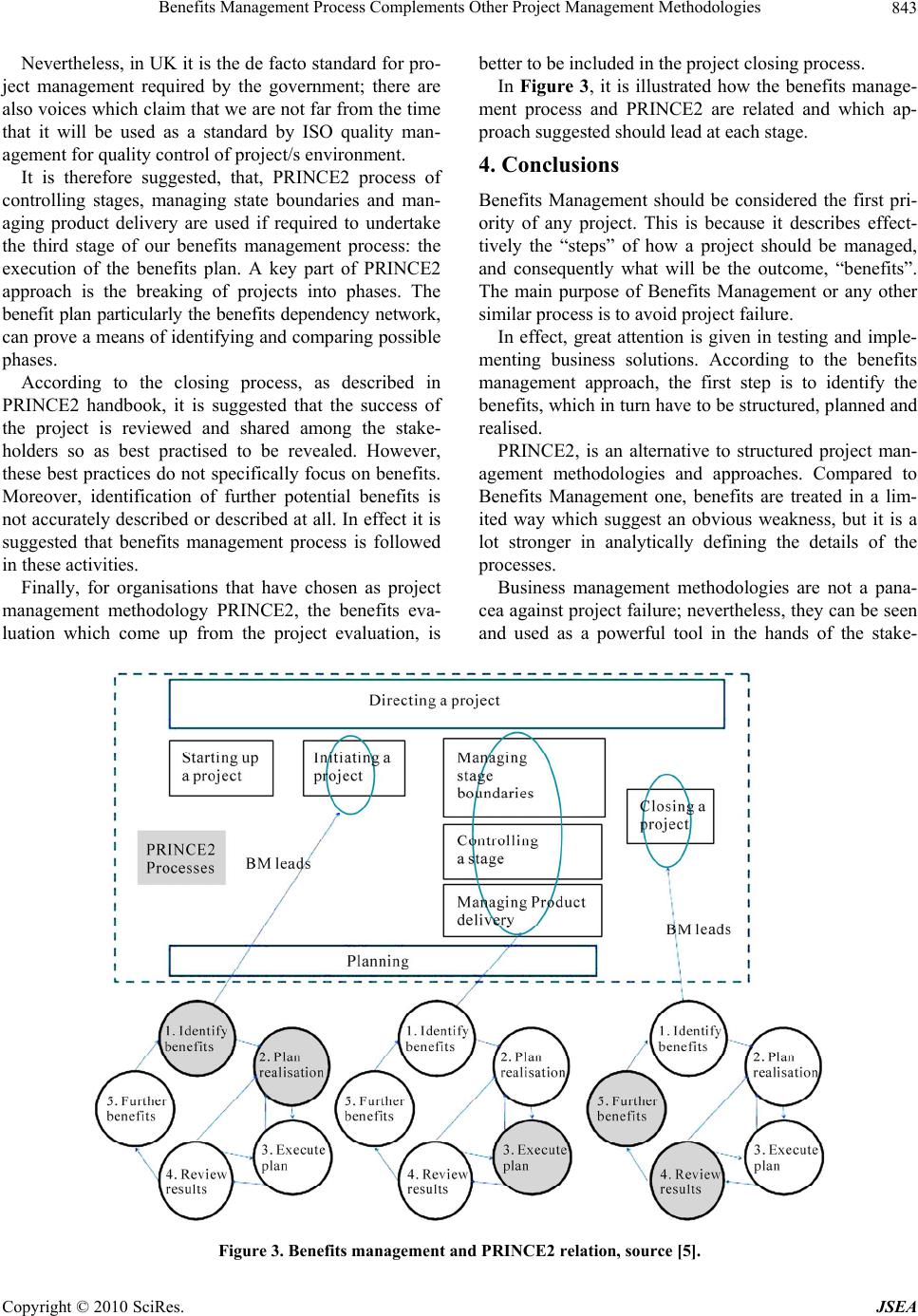 Benefits Management Process Complements Other Project Management Methodologies Copyright © 2010 SciRes. JSEA 843 Nevertheless, in UK it is the de facto standard for pro- ject management required by the government; there are also voices which claim that we are not far from the time that it will be used as a standard by ISO quality man- agement for quality control of project/s environment. It is therefore suggested, that, PRINCE2 process of controlling stages, managing state boundaries and man- aging product delivery are used if required to undertake the third stage of our benefits management process: the execution of the benefits plan. A key part of PRINCE2 approach is the breaking of projects into phases. The benefit plan particularly the benefits dependency network, can prove a means of identifying and comparing possible phases. According to the closing process, as described in PRINCE2 handbook, it is suggested that the success of the project is reviewed and shared among the stake- holders so as best practised to be revealed. However, these best practices do not specifically focus on benefits. Moreover, identification of further potential benefits is not accurately described or described at all. In effect it is suggested that benefits management process is followed in these activities. Finally, for organisations that have chosen as project management methodology PRINCE2, the benefits eva- luation which come up from the project evaluation, is better to be included in the project closing process. In Figure 3, it is illustrated how the benefits manage- ment process and PRINCE2 are related and which ap- proach suggested should lead at each stage. 4. Conclusions Benefits Management should be considered the first pri- ority of any project. This is because it describes effect- tively the “steps” of how a project should be managed, and consequently what will be the outcome, “benefits”. The main purpose of Benefits Management or any other similar process is to avoid project failure. In effect, great attention is given in testing and imple- menting business solutions. According to the benefits management approach, the first step is to identify the benefits, which in turn have to be structured, planned and realised. PRINCE2, is an alternative to structured project man- agement methodologies and approaches. Compared to Benefits Management one, benefits are treated in a lim- ited way which suggest an obvious weakness, but it is a lot stronger in analytically defining the details of the processes. Business management methodologies are not a pana- cea against project failure; nevertheless, they can be seen and used as a powerful tool in the hands of the stake- Figure 3. Benefits management and PRINCE2 relation, source [5]. 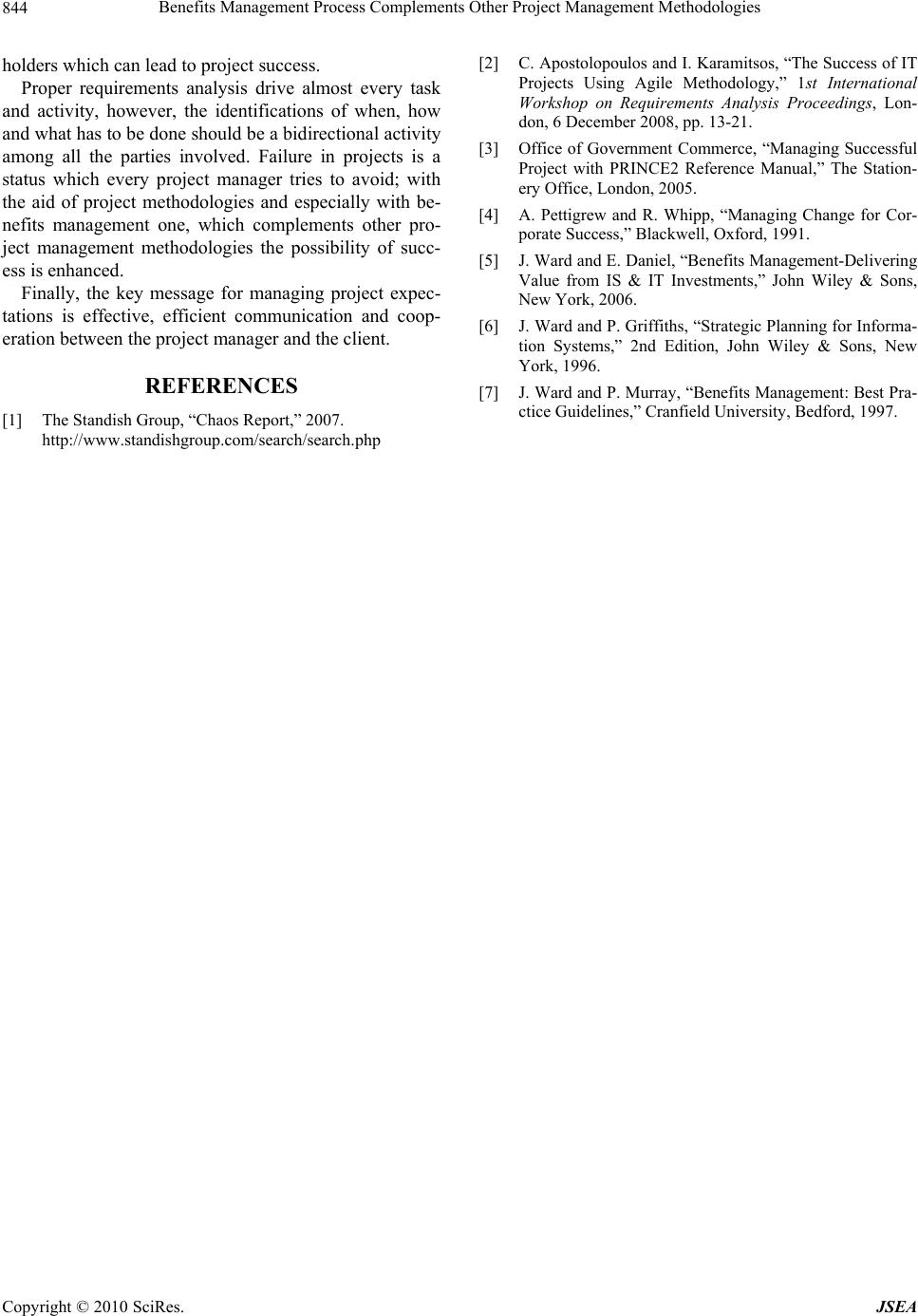 Benefits Management Process Complements Other Project Management Methodologies Copyright © 2010 SciRes. JSEA 844 holders which can lead to project success. Proper requirements analysis drive almost every task and activity, however, the identifications of when, how and what has to be done should be a bidirectional activity among all the parties involved. Failure in projects is a status which every project manager tries to avoid; with the aid of project methodologies and especially with be- nefits management one, which complements other pro- ject management methodologies the possibility of succ- ess is enhanced. Finally, the key message for managing project expec- tations is effective, efficient communication and coop- eration between the project manager and the client. REFERENCES [1] The Standish Group, “Chaos Report,” 2007. http://www.standishgroup.com/search/search.php [2] C. Apostolopoulos and I. Karamitsos, “The Success of IT Projects Using Agile Methodology,” 1st International Workshop on Requirements Analysis Proceedings, Lon- don, 6 December 2008, pp. 13-21. [3] Office of Government Commerce, “Managing Successful Project with PRINCE2 Reference Manual,” The Station- ery Office, London, 2005. [4] A. Pettigrew and R. Whipp, “Managing Change for Cor- porate Success,” Blackwell, Oxford, 1991. [5] J. Ward and E. Daniel, “Benefits Management-Delivering Value from IS & IT Investments,” John Wiley & Sons, New York, 2006. [6] J. Ward and P. Griffiths, “Strategic Planning for Informa- tion Systems,” 2nd Edition, John Wiley & Sons, New York, 1996. [7] J. Ward and P. Murray, “Benefits Management: Best Pra- ctice Guidelines,” Cranfield University, Bedford, 1997. |

